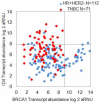Identification of BRCA1 Deficiency Using Multi-Analyte Estimation of BRCA1 and Its Repressors in FFPE Tumor Samples from Patients with Triple Negative Breast Cancer
- PMID: 27077368
- PMCID: PMC4831669
- DOI: 10.1371/journal.pone.0153113
Identification of BRCA1 Deficiency Using Multi-Analyte Estimation of BRCA1 and Its Repressors in FFPE Tumor Samples from Patients with Triple Negative Breast Cancer
Abstract
Purpose: Apart from germ-line BRCA1-mutated breast cancers, a significant proportion of women with sporadic triple negative breast cancer (TNBC) sub-type are known to harbour varying levels of BRCA1-dysfuction. There is currently no established diagnostic method to identify these patients.
Methods: The analysis was performed on 183 primary breast cancer tumor specimens from our longitudinal case-series archived as formalin-fixed-paraffin-embedded (FFPE) blocks comprising 71 TNBCs and 112 Hormone receptor positive HER2 negative (HR+HER2-) tumors. Transcript levels of BRCA1 and two of its repressors ID4 and microRNA182 were determined by TaqMan quantitative PCR. BRCA1 protein was detected immunohistochemically with the MS110 antibody.
Results: The representation of BRCA1 and its repressor ID4 as a ratio led to improved separation of TNBCs from HR+HER2- compared to either measure by itself. We then dichotomised the continuous distribution of each of the three measurements (Protein, MIRNA and transcript:repressor ratio) into categories of deficient (0) and adequate (1). A composite BRCA1 Deficiency Score (BDS) was computed by the addition of the score for all three measures. Samples deficient on 2 or more measures were deemed to be BRCA1 deficient; and 40% of all TNBCs met this criterion.
Conclusion: We propose here a simple multi-level assay of BRCA1 deficiency using the BRCA1:ID4 ratio as a critical parameter that can be performed on FFPE samples in clinical laboratories by the estimation of only 3 bio-markers. The ease of testing will hopefully encourage adoption and clinical validation.
Conflict of interest statement
Figures







References
-
- Miki Y, Swensen J, Shattuck-Eidens D, Futreal PA, Harshman K, Tavtigian S, et al. A strong candidate for the breast and ovarian cancer susceptibility gene BRCA1. Science. 1994;266(5182):66–71. Epub 1994/10/07. . - PubMed
-
- Gapstur SM, Dupuis J, Gann P, Collila S, Winchester DP. Hormone receptor status of breast tumors in black, Hispanic, and non-Hispanic white women. An analysis of 13,239 cases. Cancer. 1996;77(8):1465–71. Epub 1996/04/15. 10.1002/(SICI)1097-0142(19960415)77:8<1465::AID-CNCR7>3.0.CO;2-B . - DOI - PubMed
-
- Huo D, Ikpatt F, Khramtsov A, Dangou JM, Nanda R, Dignam J, et al. Population differences in breast cancer: survey in indigenous African women reveals over-representation of triple-negative breast cancer. Journal of clinical oncology: official journal of the American Society of Clinical Oncology. 2009;27(27):4515–21. Epub 2009/08/26. 10.1200/JCO.2008.19.6873 - DOI - PMC - PubMed
Publication types
MeSH terms
Substances
LinkOut - more resources
Full Text Sources
Other Literature Sources
Research Materials
Miscellaneous

